Independent Surveyors can help solve problems
We are qualified independent surveyors who can provide help and advice with regard to building surveys, structural surveys, independent valuations, property surveys, full structural reports, engineers reports, specific defects report, home buyers reports or any other property matters . As you can see from this article we use lots of sketches and photos in our reports as the feedback we have from you the client is that the sketches and photos really help them understand the reports. We, of course, like to meet you at the property during the survey and we are more than happy to talk to you about the reports.
For further advice with regard to condensation, mould and air movement in your home or any other property matter, please free phone 0800 298 5424 for a friendly chat with one of our surveyors.
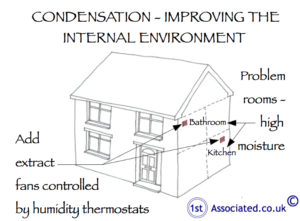
High moisture areas within a home
Condensation, where it comes from and what causes it?
Unfortunately we are now frequently seeing problems with condensation in properties and regularly see condensation more and more – why? Condensation can be in the form of mould on the walls and this black mould on the walls can be interpreted in many different ways by both the people living in the property or the people about to buy the property or the tradesmen that come to look at the property. Often people fear it relates to a roof leak or a pipe leak or something similar. However in our experience black mould is very usually condensation.

Condensation causes black mould
on walls and ceilings

Black mould on a wall

Condensation on window
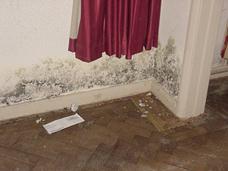
Black mould on wall

Taking specific damp meter readings
One theory on condensation that is not heard that often
We have over the years heard time and time again that the problems relate to the user of the property and how they use it. Whilst we have dealt with cases where this is very much correct and with a little knowledge people get to better understand how their houses and properties work, we feel with our ever increasing requirements to warm a house and producing more and more situations where the houses and flats are simply not designed to cope with the way that we are using them. What is interesting with the ever increasing requirements to be more energy efficient is the way that houses are being built is changing although outwardly it doesn't look like it; this we feel has an impact on the mould and how frequently it will occur in properties.
Lifestyle
Of course there are many cases where the condensation is being caused by the lifestyle of the occupant/user. We don't think it is as clear cut as it is often made out to be.
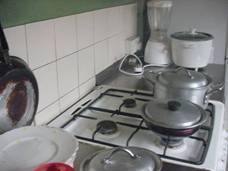
Cooking produces steam

Washing drying on radiators can
cause condensation
The way we design and build houses is constantly changing
It should be remembered that whilst our houses from a hundred or two hundred years ago still look fairly similar to houses of today, i.e. they have walls and they have a roof, they have windows and they sometimes have a chimney, the materials and the way that we are building the houses has varied considerably. There have been changes in design from everything from the architects and designers that originally designed the houses to the way users modify them with the ever popular DIY alterations and amendments, to the way the Building Regulations is forcing developers to look at the way they build.

Victorian properties will have been
constructed differently to modern
properties. The red ovals represent
areas of poor thermal efficiency such
as windows and the roof
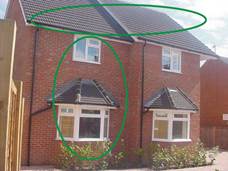
Modern properties built will be more
thermally efficient then older properties.
The green ovals represent good thermal
efficiency
Leaky houses versus airtight houses
This is a term that has been used more and more referring to old houses that they are leaky houses and leak heat; a modern house being airtight. However with these terms we also need to remember that an older house tends to work very differently with the materials breathing whereas the more modern house tends to work with watertight and airtight solutions.

Older properties are built with breathable materials
whereas modern properties are air tight
Airtight houses – do they cause condensation problems?
We recently went to a conference where the Architect proudly explained how he had designed airtight houses that were like ‘Tupperware' boxes as they were so tightly sealed. We are not sure whether this will give us the required or desired effect for an environment that we want to all live in. Whilst it may be a lot warmer, and older houses to some extent are draughty (you can always put a jumper on), we believe there will be a lot of problems to come with this type of design.
We are aware that the above paragraph is very much out of step with modern thinking with a push for ever more energy efficient houses however we have spent time in the past with architects. We understand that they produce a drawing, manage the construction and then move onto their next new project. However as building surveyors we get to see the results of the design and we are aware that architects, although many of them are very clever, don't get to understand the problems that their designs have caused due to the way that people live within properties and this is often the unknown or uncertain factor.

Modern properties with double glazing
and insulation in the walls and roof

Roof is lined with a protective underlayer
in this modern property
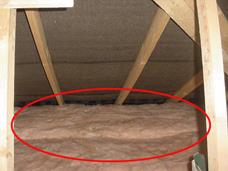
Insulation in the roof of a modern property
In a pre-war property, airflow both in the house and into the house would have been via many ways. The windows, for example, were sliding sash windows, and didn't fit that well which gave air movement and real fires were used which also gave real air movement in a property.

Victorian property with sash windows
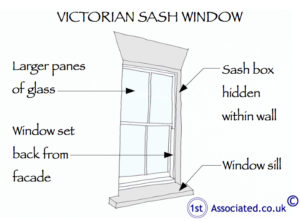
Victorian sash window
We shouldn't forget that it was common to have a suspended timber floor like we have shown in the adjoining sketch. Underneath the suspended timber floor you had air movement from the airbricks that were outside the property. This air movement often included air movement up between the floor boards as we didn't have wall to wall carpet, we simply had a carpet for the middle of the floor and the air movement was considerable underneath the property.
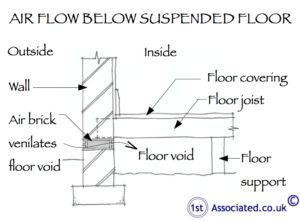
Suspended timber floor
Although we haven't experienced it, we are told that in a suspended timber floor sometimes you can still feel draughts coming up through the floor boards. We are not saying that these environments were ideal, as it certainly wouldn't be as warm as today with a draughty house, but it did give a movement of air around a property which in turn reduces the chances of condensation.
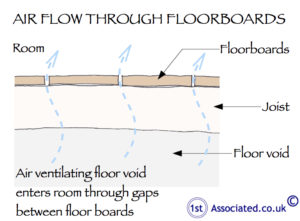
Airflow through floor boards
Other articles on surveying properties and building problems that may be of interest
The following articles give further information related to this topic, but don't forget that we have written articles on many different areas of property:
Condensation and Cold Bridging
Condensation Problems
Do all houses have condensation?
Energy Efficiency, Have we got it all wrong?
Why you have never seen any Building Surveys or Structural Surveys like ours
The arrival of central heating
With the arrival of central heating, back boilers and electric storage heaters, this meant that there wasn't as much air movement as you don't need air as you do with a real fire to activate this type of heating. There was air circulation often caused by the non airtight windows and doors which allowed movement around the property. There was also movement by the different materials that the heat came into contact with such as the single glazed windows which then cooled the air and the ceilings which also allowed the warm air to go up through them.
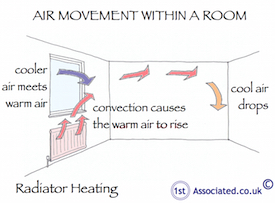
Air movement
The 1970's and Energy Efficiency arrives
The heading says that in the 1970's Energy Efficiency arrives; this is not strictly true as most people would say that Energy Efficiency arrived because of the oil crisis and the need to save money. This was the first time people looked at how the buildings worked from an Energy Efficiency point of view.
This resulted in basic improvements such as insulations to lofts and insulations to cavities and the starting of the multi-million or is it multi-billion pound double glazing industry. This then changed how air moved within a house. No longer did you have such big differences between the wall temperatures and the window temperatures and the ceiling temperatures which means that air starts to sit in the same place within a house and there is no way when it gets over-moist for it to escape.

Thermal image
Commercial properties changed too
Also in the 1970's Energy Efficiency was starting to be thought about in commercial properties and there are surveyors who recall how they helped by adding what is known as warm roofs, which is a form of insulation above swimming pool roofs. If you think about swimming pools they are the ultimate in heat loss. Also, how they used air recycling within such places as sports centres to pass the warm air generated by the swimming pool around the property and how they looked at improving the efficiency of boilers in care homes and schools. Back in the 1970's generally was a very easy win to alter, amend and improve a property; we have moved a long way since this time.
Condensation and humidity in a house
There are all sorts of terms used in relation to condensation. One of the main ones to understand is humidity. This is what needs to be generated amongst other things to cause condensation. Humidity refers to an over moist atmosphere, this occurs when activity takes place which creates humidity. This can, for example be:
Cooking
Showers
Baths, particularly long baths
Washing
Washing machines
Drying washing on radiators on a rainy day

Black ceiling mould
The air movement in a house also has to be considered, a lack of air movement results in humidity moving with the flow of warm air rising and cold air sinking and the moisture being drawn to the colder rooms, often to colder spots in colder rooms such as the corners or within cupboards. This results in a blackening of these areas, which is why air movement is so important in a property.
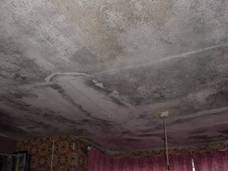
Black ceiling mould
What makes these areas black?
It's the dust and skin particles that are drawn through the air and onto the wall.
Heat loss in a poorly insulated house
If you look at a typical older property there is considerable heat loss. Everybody is forever trying to improve the heat loss in a house (see the adjacent sketch). Approximately:
25% goes through the roof
35% goes through the walls
25% goes through the windows
15% goes through the floors
Heat loss in a house
The sketch shows how heat travels through materials.

Heat loss in a house
There are also other things that affect a property such as the draughtiness of it and what is known as a leaky house, which we mentioned earlier, and equally a modern house wouldn't have such draughtiness, it would have airtight areas.
How does air move in a modern airtight house/flat?
The best example or the worst example that we see of this is in a modern high-spec flat or apartment which is part of perhaps a scheme of twenty plus apartments. Here, the flat or apartment is surrounded by well insulated other flats and apartments so if you are on the second floor for example, you may only have one external wall, the other walls are internal, either onto adjoining flats or apartments or corridors. We have surveyed properties where people who live in this type of environment say that they hardly ever need to put their heating on, which is an incredible thing to say in our climate!
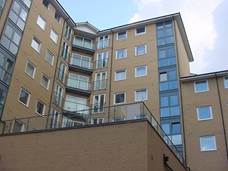
Block of modern flats
Ventilation/Extraction
A way of helping to reduce condensation is to have large humidity controlled extract fans within the kitchens and bathrooms which are moisture generating areas. Beware that extract fans are vented to outside air rather than into the roof as per the photo below!

Small extract in bathroom
needs improving
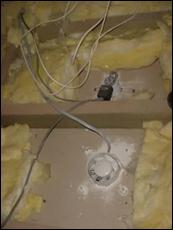
Extract fan venting directly
into roof
It's all about air movement?
From the article you should now understand that within a property it is not about air movement but controlled air movement. Draughts as such are said to be a problem as we move towards a modern air sealed house (remember the Tupperware box idea) we will have less, what are known as leaky houses and a much more controlled environment and with it we will need to understand that if we create a lot of humidity we need to get rid of it as quickly as possible before it causes mould in a property.
What do the ovals or circles in our building surveys mean?
We utilise a system of ovals and circles within our structural surveys and building surveys to highlight problem areas so that you are not left wondering what the problem is.

Radiators under windows help air
movement in the room
Talk to us about condensation
We hope this article has helped you. If there is anything further that you want to know with regard to mould and condensation, as it is very unpleasant if you are living in these conditions, please do not hesitate to contact us on free phone 0800 298 5424.
Independent Surveyors
If you truly do want an independent expert opinion from a building surveyor we are happy to do valuations, building surveys, structural surveys, structural reports, engineers reports, specific defects reports, home buyers reports or any other property matters. Please contact us on 0 800 298 5424 to have a free of charge friendly chat with one of our surveyors.
Our Good, Bad and ugly Survey
This is a building survey that we have developed over more than a decade. Our building surveys include photos, sketches and definitions. The survey also includes an action required section and an estimate of costs in the executive summary. The key thing about our reports is they are written in easy to understand plain English. We are more than happy to meet you at the property whilst carrying out the survey to discuss any specific issues you may have or have a general chat about what we have found at the end of the survey.
Examples of our surveys
If you would like to see some examples of our building surveys we are more than happy to send you these via email. As mentioned earlier our surveys contain photos, sketches and definitions that help to explain the specific problems that we find within the property.
Surveying articles
We hope you found the article of use and if you have any experiences that you feel should be added to this article that would benefit others, or you feel that some of the information that we have put is wrong then please do not hesitate to contact us (we are only human).
The contents of the website are for general information only and are not intended to be relied upon for specific or general decisions. Appropriate independent professional advice should be paid for before making such a decision.
All rights reserved by 1stAssociated.co.uk
All rights are reserved the contents of the website are not to be reproduced or transmitted in any form in whole or part without the express written permission of www.1stAssociated.co.uk
